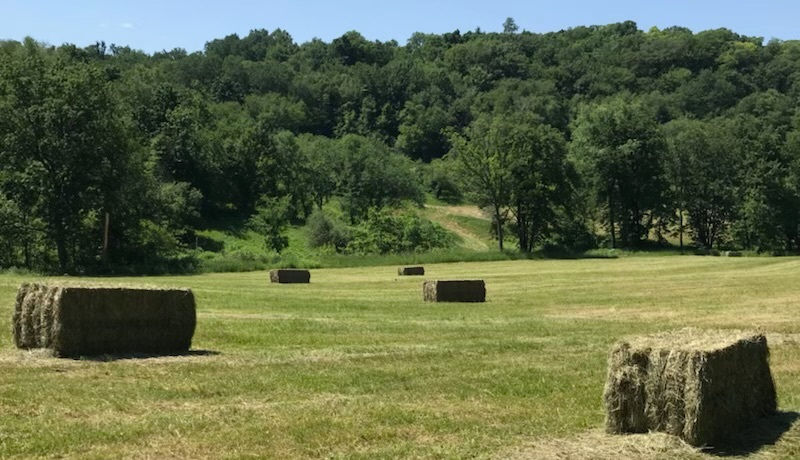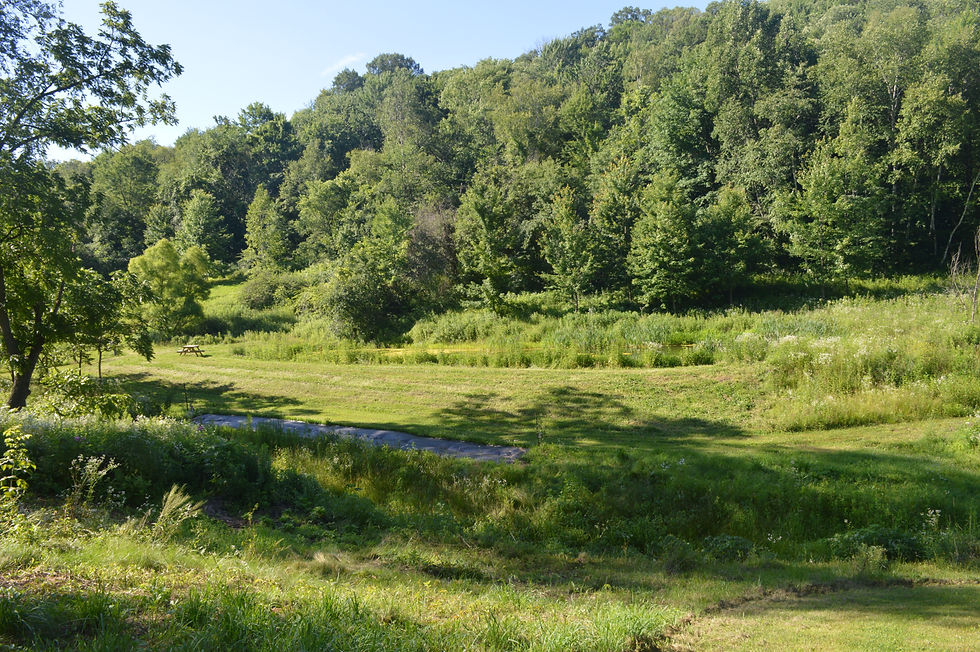The Ag Field (Part 1 of 4)
- Rebecca Clancy
- Apr 12, 2022
- 3 min read
Updated: Apr 14, 2022
Our main Ag Field has what every permaculture farmer covets: a gentle, south facing slope (about which more later). It was the perfect place to make some permaculture magic.
What follows is a list of plants in the Ag Field before and after permaculture magic was made. The Ag Field is now, in a word, edenic. It is home to dragonflies, butterflies, songbirds, hummingbirds, and bumble bees, not to mention all the life in the soil.
Before: | After: |
Fescue grass | Fescue grass |
Weeds | Weeds |
| Barley grass Alfalfa White Clover Red Clover Hairy Vetch Pine Nut trees Chestnut trees Apple trees (four varieties) Pear trees (three varieties) Cherry trees Plum trees Lavender Raspberries Hazel nuts Aronia berries Elderberries Gooseberries (four varieties) Rhubarb Grapes Prairie flowers Winter squash planted in old straw bales (four varieties) Large Kitchen garden with herbs, spices, flowers, fruits, and vegetables. Plus Three swales 45 honey bee hives Stick stacks (made with tree crowns) for songbirds |
How did we go from “before” to “after?” It all started with the swales. Swales are a way to store water on gentle (15% grade or less) south facing slopes. Here’s how they work.
A perfectly level ditch is cut across the length of the field. The earth from the ditch is piled downhill to make a mound.

As rain water saturates the land and runs downhill, it flows into the ditch. The water then slowly penetrates the land below it, creating a damp sponge, which is an ideal place to plant. The Ag Field is then drought proof due to the damp sponge. It is also flood proof because the ditch prevents erosion.
The swales are a perfect example of how to overcome the “I Can’t Possibly Do It Syndrome.” I was a permaculture farmer. I had a gentle south facing slope. I simply had to have swales. But how could I possibly dig swales? Less than a year ago I was a suburbanite. We suburbanites didn’t even hang our own Christmas lights. The “I Can’t Possibly Do it Syndrome” took hold of me. So I got an estimate from a trendy local land management outfit. It was $14,000.
That estimate sounded the death knell of the “I Can’t Possibly Do It Syndrome.” I turned where everyone turns nowadays – to YouTube. Now this is not to say that you're invincible. There are cases where the "I Can't Possibly Do It Syndrome" is in fact the stark realization that you simply can't do it. I would not attempt to fell a fifty foot tree near power wires, for instance. But it is to say that you're not as helpless as suburban living might make you believe. Avi The Tinker, for example, was consulted by a farmer who had lived here for fifty years, but who had not committed the instruction manual to memory, about the finer features of the tractor. When we first stood before our new tractor, however, we were all riddled with the "I Can't Possibly Do It Syndrome." It's a question of discernment. You can do much more than you think.
So I bravely procured my equipment - a rented laser level, a rented excavator (size small), and stick-in-the-ground flags. Well begun is half done, was my mantra.
Initially, it was trial and error with the laser level. The laser level shoots a beam from point A to point B only where it is level. You then plant your stick-in- the-ground flags on point A and point B and move onto point C. The flags then form the dig line. I eventually managed to find a level dig line that was 650 feet. The first swale would be a monster.
Then it was simply a matter of hopping in the excavator, scooping, and plopping. The first swale was not only long – it's ditch was deep and jagged. My excavating skills were as yet crude. By swale number three, however, I was digging with surgical precision.
But no sooner were the swales dug than the “I Can’t Possibly Do It Syndrome” was replaced by something even more pernicious. It can be referred to as (to credit the late Dr. Paul Farmer), “The Mountains Beyond Mountains Phenomenon.” What Farmer realized is that there’s no end to it. You think you’ve addressed a problem and it’s in fact just the first step on an endless sequence of related problems. This phenomenon is particularly prevalent on a farm. It’s like Whack-A-Mole ad infinitum.
Bottom line: The monster swale, hereinafter, "Big Daddy," was an eyesore. Not only was the ditch deep and jagged, the mound was an uneven, clumpy, ankle turning nightmare. It was nothing like the ones on YouTube…..(To be continued)








interesting blog- had no idea you needed and tackled excavations on your farmland to that degree- you and your children are amazing and certainly have the "I Can spirit !"